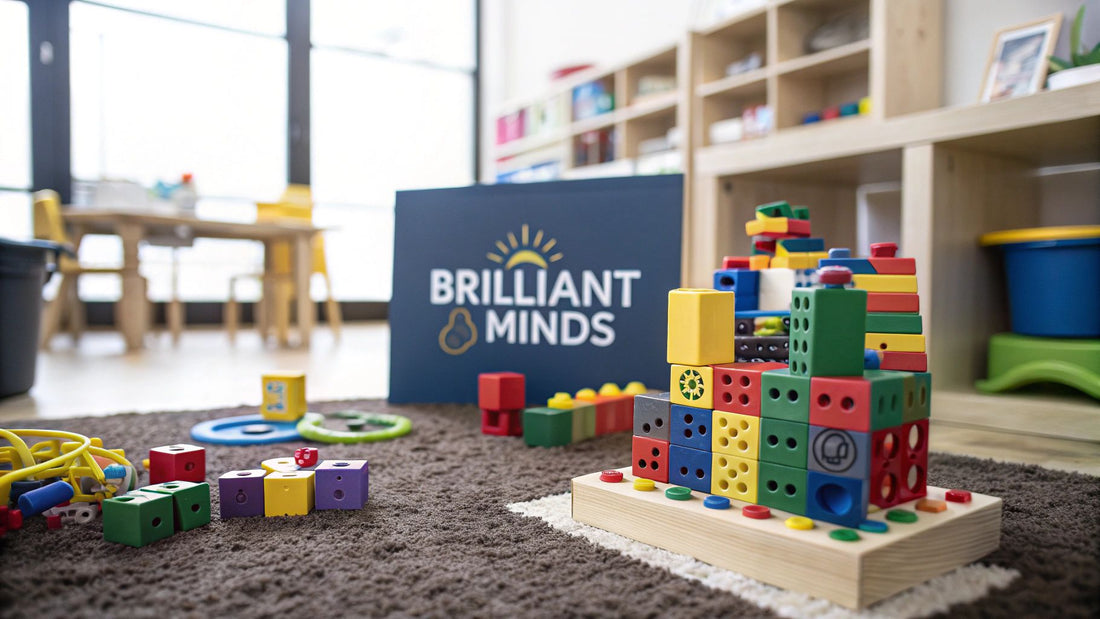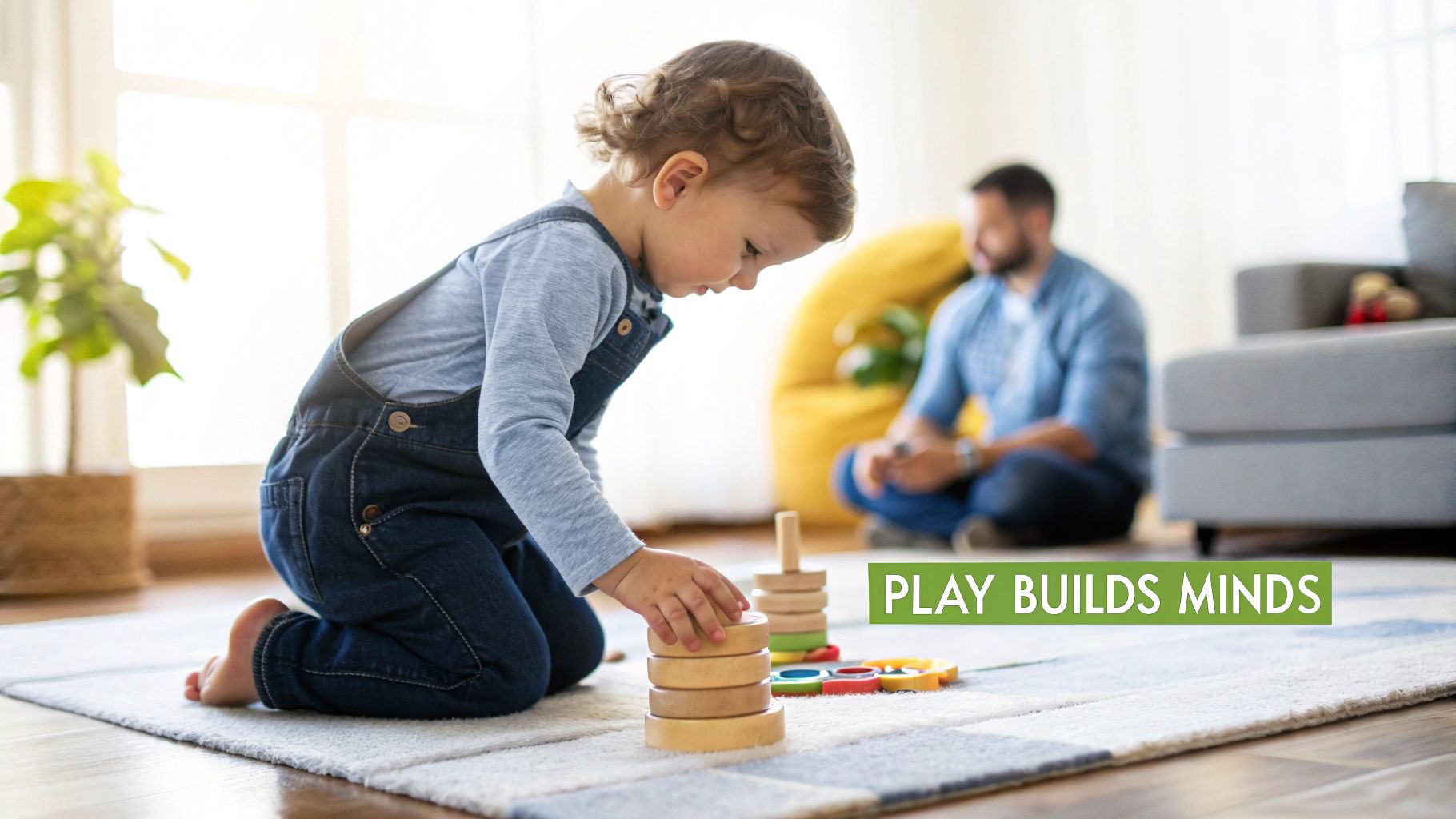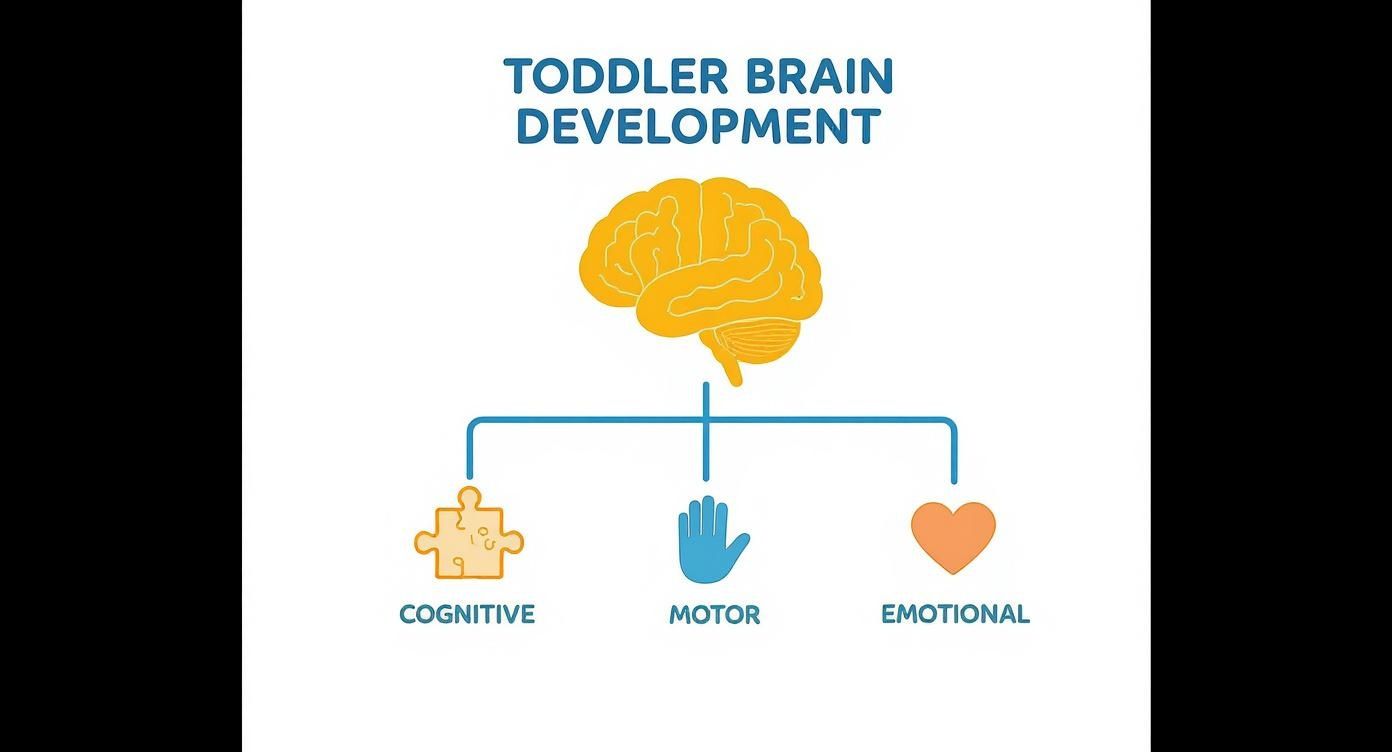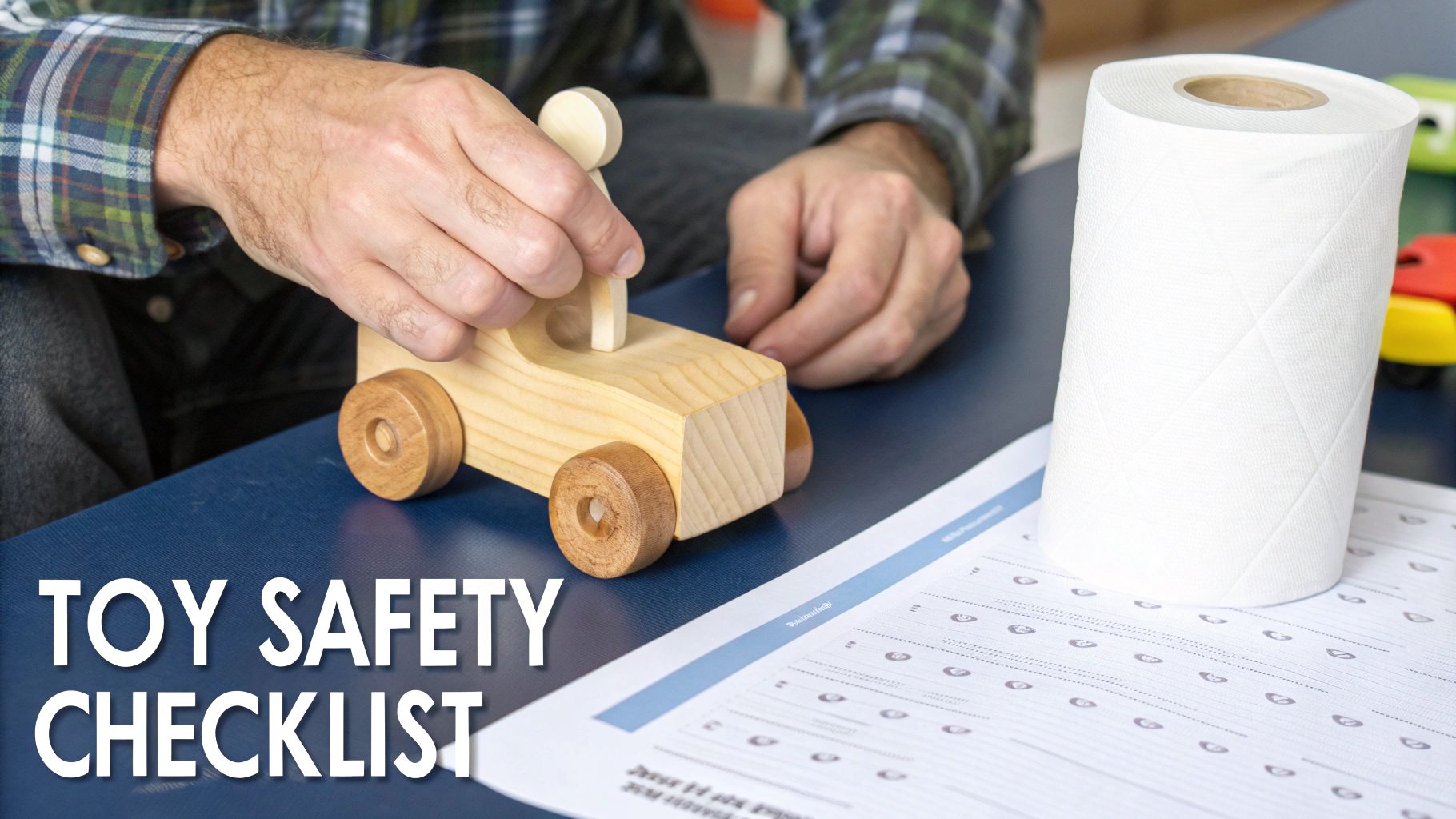
Toddler Problem Solving Toys That Build Brilliant Minds
Share
Don't be fooled by the bright colors and fun shapes—toddler problem solving toys are far more than just playthings. Think of them as essential tools for early development, specifically designed to get a child’s gears turning. They challenge a toddler's thinking, encouraging them to figure out how things work, overcome small obstacles, and achieve a goal.
The Power of Play in a Toddler’s World

Welcome to your toddler’s world—a giant, fascinating puzzle just waiting to be solved. For a young child, play isn't just a way to pass the time; it's the fundamental work of early childhood. It’s where real learning happens, where curiosity catches fire, and where the building blocks for all future skills are laid.
Toys as Mental Playgrounds
It helps to think of toddler problem solving toys not as simple objects, but as interactive "mental playgrounds." A shape sorter isn't just a box with holes; it's a child's first real lesson in trial and error. Stacking rings teach sequencing and spatial relationships long before those words have any meaning.
These kinds of toys create a safe space for toddlers to experiment and learn on their own terms. They get to:
- Explore cause and effect: "If I push this button, the light flashes!"
- Test their theories: "Will this wobbly tower stay up if I add just one more block?"
- Build resilience: Learning to try, try again after a puzzle piece doesn't quite fit.
This hands-on exploration is absolutely vital. In fact, a recent survey showed that 58% of U.S. parents are now actively choosing toys that help their children build specific skills, with problem-solving at the top of the list.
Through this playful work, toddlers aren't just having fun. They are literally constructing the foundation of their cognitive abilities, learning that challenges can be overcome and that persistence pays off.
To really grasp the long-term impact of this, it’s worth understanding the profound importance of early childhood education in shaping a child's entire future. These early experiences, guided by thoughtful play, are where the journey to building a brilliant, adaptable mind truly begins.
How These Toys Shape Your Toddler's Brain
When your toddler is trying to stack a set of rings or push a square block into a square hole, it's so much more than just a cute photo opportunity. Inside their little head, a massive construction project is underway, with connections firing and wiring at an incredible pace. Those simple, playful moments are actually building the fundamental architecture for a lifetime of learning.
Think of it this way: your toddler's brain is like a brand-new city being built from scratch. Each time they play with toddler problem solving toys, they're laying down new roads, which are really just neural pathways. The more they use these roads through practice and experimentation, the stronger and more efficient they become.
Building Cognitive Foundations
A simple set of building blocks is secretly a hands-on physics lesson. When the tower comes tumbling down, your child learns about gravity, balance, and what makes a structure stable. They aren't just stacking; they're testing a hypothesis. "What happens if I put this big one on top?" That cycle of try, fail, and try again is the very heart of critical thinking.
This kind of play strengthens a few key cognitive areas:
- Spatial Awareness: Figuring out how puzzle pieces nestle together or how to arrange blocks into a specific shape sharpens their understanding of objects in a 3D space.
- Logical Sequencing: Toys like stacking rings have a natural order to them. The biggest ring has to go first for the tower to work, introducing the basic concept of sequence.
- Cause and Effect: A shape sorter gives immediate feedback. The square block only fits in the square hole. It's a direct, hands-on lesson.
Every time a child solves one of these little challenges, their brain gets a hit of dopamine—the "feel-good" chemical. This reward system reinforces the behavior, making them excited to tackle the next puzzle. It builds a genuine, internal motivation to learn and overcome obstacles.
More Than Just Brainpower
But the benefits don't stop with brainpower. As a toddler carefully pinches a puzzle knob or clicks interlocking blocks together, they're fine-tuning their fine motor skills and hand-eye coordination. These are the same physical skills they'll need later for writing their name, buttoning a coat, or using a fork.
On top of that, these toys build emotional resilience. The frustration of a puzzle piece not fitting is actually a valuable experience. By encouraging them to keep trying, you're helping them develop persistence and a healthy attitude toward challenges. They learn that effort leads to success, which is a cornerstone of a growth mindset.
Parents are catching on. The market for educational toys is growing, with activity and developmental toys holding a major share. It's clear that parents see the value in toys that actively support a child's whole development. You can get more insights on the growth of the infant and toddler toy market at gminsights.com.
When you bring these toys into playtime, you're making a direct investment in your child’s cognitive, emotional, and physical future, one block at a time. For those interested in how this applies to structured learning, our guide on learning through STEM toys offers a deeper dive.
Choosing the Right Toys for Every Stage
Walking into a toy store can feel like navigating a jungle, with every colorful box promising to be the key to your child's genius. But here's the secret: it's not about finding one "perfect" toy. The real goal is to pick the right toddler problem solving toys that click with where your little one is right now in their development. A toy that fascinates a 3-year-old could easily overwhelm and frustrate a 1-year-old.
Think of it like buying shoes. You wouldn't put your toddler in a pair that's three sizes too big, right? They'd just trip up. The same goes for toys. We're looking for that "just right" fit—something that offers a little challenge to keep them engaged, but isn't so tough that they give up. This is how a playroom transforms into a personal little learning lab.
Matching Toys to Milestones
For the youngest toddlers, say around 12 to 18 months, the world is all about touch, taste, and sound. They're just getting the hang of their pincer grasp and figuring out that when they push a button, something cool happens (hello, cause and effect!). Simple toys that give immediate feedback are pure gold at this age.
Fast forward to age three, and suddenly you have a little engineer and storyteller on your hands. They can follow multiple steps, build elaborate structures, and live entirely in a world of make-believe. Their toys need to keep up with that leap in thinking, offering more open-ended ways to play.
This infographic breaks down how different types of play fuel the core areas of your toddler's growth, from thinking skills to physical coordination.

It’s a great visual reminder that a single, well-chosen toy doesn't just do one thing. It can help connect the dots between cognitive, motor, and even emotional skills all at once.
Age-Appropriate Toy Recommendations
To make it a bit less overwhelming, let's break down some go-to toy types for each stage of toddlerhood.
-
For 1-Year-Olds (The Explorers): At this point, we're building the foundations. Think chunky knob puzzles (maybe just one or two pieces), simple shape sorters, and classic stacking rings. These are fantastic for hand-eye coordination and learning the basics of trial-and-error.
-
For 2-Year-Olds (The Builders): Your two-year-old is ready for a little more of a challenge. This is the perfect time to introduce simple interlocking blocks (like Duplos) for early engineering adventures. Puzzles with 4-6 pieces hit the sweet spot for their growing spatial awareness, and basic lacing beads are a winner for fine motor practice.
-
For 3-Year-Olds (The Imagineers): Three-year-olds are ready for more abstract thinking. Magnetic tiles are amazing for exploring 3D construction and basic physics. You can also level up to more complex puzzles with 10-15 pieces or introduce beginner pattern blocks to encourage planning and critical thinking.
To see this in action, the table below maps out how specific toys align with the skills your toddler is developing at each age.
Age-Appropriate Problem Solving Toys and Their Benefits
| Age Group | Recommended Toy Types | Primary Skills Developed |
|---|---|---|
| 12-18 Months | Chunky puzzles, shape sorters, stacking rings | Hand-eye coordination, object permanence, basic cause-and-effect |
| 18-24 Months | Simple building blocks, lacing beads, nesting cups | Fine motor skills, spatial reasoning, size differentiation |
| 2-3 Years | Puzzles (4-15 pieces), magnetic tiles, pattern blocks | Advanced problem-solving, critical thinking, imaginative construction |
This comparison helps visualize the progression, showing how foundational skills learned with simpler toys set the stage for tackling more complex challenges later on.
The best problem-solving toys grow with your child. Open-ended toys like a quality set of wooden blocks can be used for simple stacking at age one and for building elaborate cities by age three. Their value lies in their versatility.
Creating a play space that invites this kind of exploration is just as important as the toys themselves. If you're drawn to a child-led, structured approach, looking into Montessori materials for home can offer some wonderful ideas for setting up your environment.
Ultimately, the room itself can either encourage or hinder play. Check out these fantastic tips to decorate a kid's bedroom to help you create a space that’s not just organized, but truly inspiring for your little problem solver. When you thoughtfully curate both the tools and the space, you give your child the confidence to explore, learn, and grow.
Your Essential Toy Safety Checklist

A fantastic toy is only as good as it is safe, especially when your curious toddler is involved. Their natural instinct is to explore everything with their hands and mouth, which makes safety a non-negotiable part of the equation.
Before you bring any new toddler problem solving toys into your home, running through a quick safety check is an absolute must. Think of it as your own personal quality control. This isn't about being fearful, but about being informed and proactive so playtime is always a positive experience.
Spotting Choking Hazards Instantly
The single biggest concern for this age group is the risk of choking. Small parts can easily detach and become a serious danger. Thankfully, there’s a simple, effective test you can do right at home.
The "toilet paper roll test" is a reliable rule of thumb for any child under three. Can the toy, or any piece of it, fit entirely inside an empty toilet paper roll? If the answer is yes, it's a potential choking hazard. This quick check takes just seconds and is an easy way to screen every toy that comes into your house.
Decoding Materials and Construction
Beyond the size of the toy, what it's made of is equally important. Toddlers chew on everything, so you want to be sure the materials are non-toxic and built to last.
- Look for Safe Labels: Always check the packaging for labels like "non-toxic," "BPA-free," and "lead-free paint." Reputable manufacturers will make this information clear and easy to find.
- Inspect for Sturdy Construction: Give the toy a good squeeze and pull. Does it feel solid? Check for splinters on wooden toys and sharp edges on plastic ones. Seams should be tight, and parts shouldn't feel loose or wobbly.
- Check Batteries and Magnets: If a toy has batteries, make sure the compartment is secured with a screw. Small, powerful magnets also pose a serious risk if swallowed, so check that they are completely sealed within the toy's structure.
Safety isn’t just about the toy itself but also about creating a safe play environment. Regularly inspect older toys for wear and tear, such as cracks, loose parts, or chipping paint, and discard anything that is no longer in safe condition.
By making these quick inspections a habit, you can confidently curate a collection of problem-solving toys that are not only brilliant for your toddler's development but also completely safe for every adventure.
Cultivating a Problem-Solving Mindset
Even the best toddler problem solving toys are only half of the story. The other, more important half is you.
When you act as a guide, cheerleader, and co-adventurer, simple playtime turns into a powerful lesson on how to think, persevere, and innovate. The real goal isn't just to solve the puzzle in front of them—it's to build an internal mindset that sees challenges as exciting opportunities instead of frustrating dead ends.
This whole process starts with how we talk to them during play. It’s so tempting to jump in and show a frustrated toddler exactly how to fit the piece or stack the block. But guiding them with questions empowers their own thinking process far more effectively.
The Power of Open-Ended Questions
Instead of just giving them the solution, try asking gentle, open-ended questions that get their gears turning. This simple switch changes the game from finding the one right answer to exploring all the possibilities.
A few simple prompts can make a world of difference:
- "What do you think might happen if we turn it this way?"
- "That's a cool idea! What else could we try?"
- "Hmm, I wonder why that block made the tower fall. What should we do differently?"
This approach shows them their effort matters and encourages them to become active problem-solvers, not just kids waiting for instructions. It teaches them that their ideas have value, which is exactly the kind of confidence they need to tackle future challenges. For those with little climbers at home, using this supportive questioning while they navigate a structure like a Pikler triangle is a fantastic way to build their confidence. You can learn more about how these sets encourage safe, independent problem-solving right here.
Modeling Resilience and Celebrating Effort
Remember, your toddler is always watching you. When you model a positive, can-do attitude towards challenges, you're handing them a powerful blueprint for their own behavior.
If a block tower tumbles, an exaggerated, "Uh-oh! Let's build it again, but stronger this time!" is way more impactful than a frustrated sigh.
The most important lesson you can teach is to celebrate the effort, not just the success. Praise their persistence, their creative attempts, and their willingness to try again. This focus on the process builds resilience and a growth mindset.
The market for these kinds of developmental tools is blowing up, which shows a growing understanding of their importance. The global children's intellectual toys market, which includes essentials like building blocks and puzzles, is valued in the billions and keeps growing. This trend is largely driven by parents who see the incredible value of fostering cognitive skills through play from day one. You can discover more insights about the children's intellectual toys market on archivemarketresearch.com.
By pairing these amazing toys with your own intentional guidance, you cultivate a true problem-solving mindset that will serve your child for a lifetime.
Common Questions About Problem Solving Toys
Even after seeing all the benefits, it's totally normal to have a few questions swirling around as you pick out problem-solving toys for your toddler. The world of early childhood development can feel like a maze, but the answers are usually simpler than you think. Let's clear up some of the most common worries so you can feel great about the playroom you're creating.
You want to give your child the best tools for growth, and it's easy to second-guess your choices. This section tackles the questions we hear most from parents, with clear, straightforward answers.
Are Expensive Educational Toys Better Than Simple Blocks
Not at all. A toy's real power comes from its ability to fire up a child's imagination and get them thinking for themselves. Classic, do-anything toys like wooden blocks or shape sorters almost always offer more learning potential than a pricey, one-trick gadget.
Think about it: a simple set of blocks can be a tower, a car, a fence for toy animals, or a bridge. That kind of flexibility teaches way more about creativity, physics, and spatial awareness than an electronic toy with only one way to play. Always choose toys that invite open-ended play over ones with a high price tag.
The most valuable toys are often 90% child and 10% toy. They give kids the tools, but the child is the one who directs the learning, the experiments, and all the fun.
How Many Problem Solving Toys Does My Toddler Need
When it comes to developmental toys, less is definitely more. A playroom overflowing with options can actually overwhelm a toddler, leading them to flit from one thing to the next without ever really digging in. A small, well-chosen collection of 5-10 high-quality, versatile toys is so much more effective.
If you want to keep things fresh, try a toy rotation system. Just pack away about half of their toys and swap them out every few weeks. It’s a simple trick that makes old toys feel brand new and encourages your little one to dive deeper and play more imaginatively with each item.
My Toddler Gets Frustrated With Puzzles Should I Avoid Them
That feeling of frustration is actually a natural—and necessary—part of learning to solve problems. Instead of taking away the challenge, you can use it as a fantastic teaching moment to help your child build resilience and persistence.
First, quickly check that the puzzle is age-appropriate. It should be tricky, but not impossible. Then, get down on the floor with your child and offer gentle guidance, not the answer. You can model how to do it by solving one piece yourself, or offer a little prompt like, "What if we try turning this piece around?"
Helping them push through that moment of frustration to find the solution is a huge confidence booster. They learn a critical life lesson: with a little effort, they can figure things out. That experience is far more valuable than the puzzle itself and builds a foundation for tackling future challenges head-on.
At Ocodile, we believe in creating tools that support this essential journey of discovery and growth. Our thoughtfully designed children's furniture provides a safe and beautiful foundation for a play environment where your little one can thrive.
Explore our collection to create a space that encourages independence and joyful learning. Shop Ocodile today.








